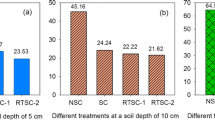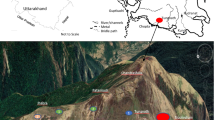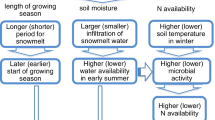Abstract
Helicoverpa armigera causes serious damage to most crops around the world. However, the impacts of snow thickness on the H. armigera overwintering pupae are little known. A field experiment was employed in 2012–2015 at Urumqi, China. At soil depths of 5, 10, and 15 cm, overwintering pupae were embedded with four treatments: no snow cover (NSC), snow cover (SC), increasing snow thickness to 1.5 times the thickness of SC (ISSC-1), and to two times the thickness of SC (ISSC-2). Results suggested that snow cover and increasing snow thickness both significantly increased soil temperatures, which helped to decrease the mortality of overwintering pupae (MOP) of H. armigera. However, the MOP did not always decrease with increases in snow thickness. The MOPs in NSC and ISSC-1 were the highest and the lowest, respectively, though ISSC-2 had much thicker snow thickness than ISSC-1. A maximum snow thickness of 60 cm might lead to the lowest MOP. The longer the snow cover duration (SCD) at a soil depth of 10 cm in March and April was, the higher the MOP was. A thicker snow cover layer led to a higher soil moisture content (SMC) and a lower diurnal soil temperature range (DSTR). The highest and the lowest MOP were at a depth of 15 and 10 cm, respectively. The SMC at the depths of 10 and 15 cm had significant effects on MOP. A lower accumulated temperature (≤0 °C) led to a higher MOP. The DSTR in March of approximately 4.5 °C might cause the lowest MOP. The largest influence factor for the MOPs at depths of 5 and 10 cm and the combined data were the SCDs during the whole experimental period, and for the MOPs at a depth of 15 cm was the soil temperature in November.






Similar content being viewed by others
Abbreviations
- NSC:
-
No snow cover
- SC:
-
Snow cover
- ISSC-1:
-
Increasing snow thickness to 1.5 times the thickness of SC
- ISSC-2:
-
Increasing snow thickness to two times the thickness of SC
- MOP:
-
Mortality of overwintering pupae
- SCD:
-
Snow cover duration
- SMC:
-
Soil moisture content
- DSTR:
-
Diurnal soil temperature range
- CMA:
-
China Meteorological Administration
- MAXST:
-
Maximum snow thickness
- MST:
-
Mean snow thickness
- PA:
-
From November 2, 2012, to April 24, 2013
- PB:
-
From November 2, 2013, to April 30, 2014
- PC:
-
From November 2, 2014, to April 24, 2015
- PSC:
-
Period of snow cover
References
Ayres MP, Lombardero MJ (2000) Assessing the consequences of global change for forest disturbance from herbivores and pathogens. Sci Total Environ 262:263–286
Beltrami H (2001) On the relationship between ground temperature histories and meteorological records: a report on the Pomquet station. Glob Planet Chang 29:327–348
Bokhorst S, Phoenix GK, Bjerke JW, Callaghan TV, Huyer-Brugman F, Berg MP (2012) Extreme winter warming events more negatively impact small rather than large soil fauna: shift in community composition explained by traits not taxa. Glob Chang Biol 18:1152–1162
Chen FJ, Zhai BP, Zhang XX (2003) Effects of soil moisture during pupal stage on population development of cotton bollworm, Helicoverpa armigera (Hübner). Acta Ecol Sinica 23:112–121
CMA (2003) Specification of surface air observation. Meteorological Press, Beijing, China
Decker KLM, Wang D, Waite C, Scherbatskoy T (2003) Snow removal and ambient air temperature effects on forest soil temperatures in northern Vermont. Soil Sci Soc Amer J 67:1234–1243
Eger JE Jr, Sterling WL, Hartstack AW Jr (1983) Winter survival of Heliothis virescens and Heliothis zea (Lepidoptera: Noctuidae) in College Station, Texas. Environ Entomol 12:970–975
Fitt GP (1989) The ecology of heliothis in relation to agroecosystems. Annu Rev Entomol 34:17–52
Goodrich LE (1982) The influence of snow cover on the ground thermal regime. Can Geotech J 19:421–432
Groffman PM, Driscoll CT, Fahey TJ, Hardy JP, Fitzhugh RD, Tierney GL (2001) Colder soils in a warmer world: a snow manipulation study in a northern hardwood forest ecosystem. Biogeochemistry 56:135–150
Huang J (2015) Effects of soil temperature and snow cover on the mortality of overwintering pupae of the cotton bollworm, Helicoverpa armigera (Hübner) (Lepidoptera: Noctuidae). Int J Biometeorol. doi:10.1007/s00484-015-1090-y
Huang J, Li J (2015) Effects of climate change on overwintering pupae of the cotton bollworm, Helicoverpa armigera (Hübner) (Lepidoptera: Noctuidae). Int J Biometeorol 59:863–876
Isard SA, Schaetzl RJ, Andresen JA (2007) Soils cool as climate warms in the great lakes region: 1951 – 2000. Ann Assoc Am Geogr 97:467–476
Kreyling J, Henry HAL (2011) Vanishing winters in Germany: soil frost dynamics and snow cover trends, and ecological implications. Clim Res 46:269–276
Liu ZD, Gong PY, Wu KJ, Wei W, Sun JH, Li DM (2007) Effects of larval host plants on over-wintering preparedness and survival of the cotton bollworm, Helicoverpa armigera (Hübner) (Lepidoptera: Noctuidae). J Insect Physiol 53:1016–1026
Mackiewicz MC (2012) A new approach to quantifying soil temperature responses to changing air temperature and snow cover. Polar Sci 6:226–236
Marshall KE, Sinclair BJ (2012) The impacts of repeated cold exposure on insects. J Exp Biol 215:1607–1613
Mironidis GK, Stamopoulos DC, Savopoulou-Soultani M (2010) Over-wintering survival and spring emergence of Helicoverpa armigera (Lepidoptera: Noctuidae) in northern Greece. Environ Entomol 39(4):1068–1084
Ouyang F, Hui C, Ge S, Men XY, Zhao ZH, Shi PJ, Zhang YS, Li BL (2014) Weakenin density dependence from climate change and agricultural intensification triggers pest outbreaks: a 37-year observation of cotton bollworms. Ecol Evol 4(17):3362–3374
Ouyang F, Liu ZD, Yin J, JW S, Wang CZ, Ge F (2011) Effects of transgenic Bt cotton on overwintering characteristics and survival of Helicoverpa armigera. J Insect Physiol 57:153–160
Pauli JN, Zuckerberg B, Whiteman JP, Porter W (2013) The subnivium: a deteriorating seasonal refugium. Front Ecol Environ 11:260–267
Reddy GVP, Shi PJ, Hui C, Cheng XF, Ouyang F, Ge F (2015) The seesaw effect of winter temperature change on the recruitment of cotton bollworms Helicoverpa armigera through mismatched phenology. Ecol Evol. doi:10.1002/ece3.1829
Rummel DR, Neece KC, Arnold MD, Lee BA (1986) Overwintering survival and spring emergence of Heliothis zea (Boddie) in the Texas southern high plain. Southwest Entomol 11:1–9
Slosser JE, Phillips JR, Herzog GA (1975) Overwintering survival and spring emergence of the bollworm in Arkansas. Environ Entomol 4:1015–1024
Sokratov SA, Barry RG (2001) Parameterization of an intra-seasonal variation in the thermo-insulation effect of snow cover on soil temperatures and energy balance. National Snow and Ice Data Center. http://www.breiling.org/snow/barrow.pdf
Thorn CE, Schlyter JPL, Darmondy RG, Dixon JC (1999) Statistical relationships between daily and monthly air and shallow-ground temperatures in Karkevagge, Swedish Lapland. Permafr Periglac Proc 10:317–330
Wu ZJ (1992) Relative analysis of change rule between soil moisture content in fields and change of number during Helicoverpa armigera (Hübner) pupae stage. Kun Chong ZhiShi 29(2):77–79
Wu KM, Guo YY (1995) Factors for diapause induced in cotton bollworm, Helicoverpa armigera (Hübner). Acta Phytophy Sin 22:331–336
Wu KM, Guo YY (1997) The influences of soil moisture content on emergence and cold hardiness of different geographical populations of cotton bollworm. Acta Phytoph Sinica 24(2):142–146
Wu KM, Guo YY, Wei FJ, Sun FZ (1997) On the cold hardiness of cotton bollworm, Helicoverpa armigera (Hübner. Acta Ecol Sin 17(3):298–302
Yang YT, Wang DH, Zhu MH (1998) Relation between soil moisture and emergence of cotton bollworm, Helicoverpa armigera (Hübner) (Lepidoptera: Noctuidae) and the effect of soil moisture on the occurrence of next generation. Acta Gossypii Sinica 10:210–215
Yang YT, Wang DH, Zhu MH (2001) Effects of soil characteristics on the occurrence of Helicoverpa armigera (Hübner) and its regional division. Acta Ecol Sinica 21:959–963
Zalucki MP, Daglish G, Firempong S, Twine PH (1986) The biology and ecology of Heliothis armigera (Hübner) and H. punctigera Wallengren (Lepidoptera: Noctuidae) in Australia: what do we know? Austral J Zool 34:779–814
Zalucki MP, Murray DAH, Gregg PC, Fitt GP, Twine PH, Jones C (1994) Ecology of Helicoverpa armigera (Hübner) and H. punctigera (Wallengren) in the inland of Australia: larval sampling and host plant relationships during winter and spring. Austral J Zool 42:329–346
Zhang T (2005) Influence of the seasonal snow cover on the ground thermal regime: an overview. Rev Geophys 43. doi:10.1029/2004RG000157
Zhang YJ, Tong BL, Li SD (1985) Influence of snow cover on the lower limit of permafrost in Altai Mountains. J Glaciol Geocryol 7(1):57–63
Zhang YS, Wang S, Barr AG, Black TA (2008) Impact of snow cover on soil temperature and its simulation in a boreal aspen forest. Cold Reg Sci Technol 52:355–370
Zhang XX, Wang YC, Geng JG, Shen JL (1980) Study on the outbreak factors of cotton bollworm, Helicoverpa armigera (Hübner)—relationship between soil moisture and pupation emergence. Entomol Knowl 17:9–13
Zhu XG (1979) Relationship between climate and occurrence of Helicoverpa armigera (Hübner) in catchment area in Yangzi River. China Cotton 2:35–39
Acknowledgments
The work was supported by the National Natural Science Foundation of China (41275119).
Author information
Authors and Affiliations
Corresponding author
Electronic supplementary material
Fig S1
(GIF 94 kb)
High Resolution Image
(TIFF 24 kb)
Fig S2
(GIF 10 kb)
High Resolution Image
(TIFF 600 kb)
Fig S3
(GIF 19 kb)
High Resolution Image
(TIFF 1204 kb)
Fig S4
(GIF 20 kb)
High Resolution Image
(TIFF 1197 kb)
Fig S5
(GIF 19 kb)
High Resolution Image
(TIFF 1198 kb)
Table S1
(DOC 46 kb)
Table S2
(DOC 37 kb)
Rights and permissions
About this article
Cite this article
Huang, J. Presence of snow coverage and its thickness affected the mortality of overwintering pupae of Helicoverpa armigera (Hübner) (Lepidoptera: Noctuidae). Int J Biometeorol 61, 709–718 (2017). https://doi.org/10.1007/s00484-016-1249-1
Received:
Revised:
Accepted:
Published:
Issue Date:
DOI: https://doi.org/10.1007/s00484-016-1249-1




